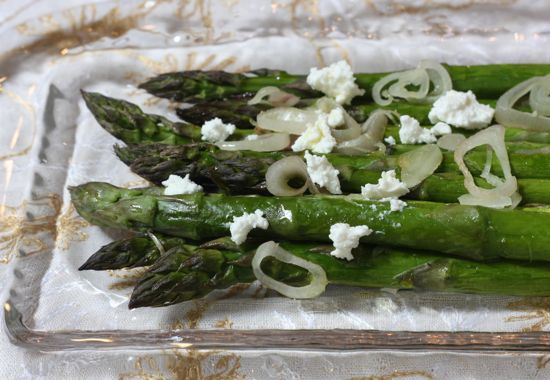The wind howled and icy showers turned to hail here last week as winter refused to loosen its grip on our weather. But the first fat bunches of beautiful green asparagus showed up in the local farmers markets and spring could not be denied.
After months of eating root vegetables and bitter greens, it was almost a religious experience to bite into the first tender stalks from Hog Farm in Hollister and revel in their sweet, grassy flavor.
There is no vegetable I anticipate more eagerly than the first asparagus of spring, in part because it’s the harbinger of fabulous produce to come. If asparagus is here, can peas and strawberries be far behind?
The first spears of the season are so tender and fresh-tasting, they require little more than properly timed cooking and perhaps a drizzle of melted butter or good extra virgin olive oil. They should still be a little crisp when you serve them. A moment too long on the heat and they’re likely to turn mushy and stringy.
I like to roast asparagus for a short time at a high temperature, which caramelizes the natural sugars and concentrates the flavors. The color remains a vivid emerald green and the taste is bright and true. Although I use an oven at this time of the year, a grill also works well when the weather warms up.
To dress them up, slice up a few shallots and roast them with the asparagus. Anoint the roasted vegetables with a slick of mustard-laced vinaigrette and sprinkle them with curds of tangy goat cheese. The shallots offer a delicate, onion accent while the vinaigrette and goat cheese serve as gentle counterpoints to the sweet stalks.
Alternatively, you can cook asparagus stalks in a single layer with about half a cup of water in a wide skillet. Bring the water to a boil, cover and cook for just a couple of minutes, until the thick part of the stalks is easily pierced with a small, sharp knife.
I never peel asparagus but I do snap off the tough ends, taking care not to lose too much in the process. I know there are fans of thick, meaty stalks and those who prefer the pencil-thin variety. I’m not that picky, though, especially early in the season when I’ll take any freshly picked local asparagus I can get.
There’s no denying that fat spears are the easiest to roast or steam to the proper texture. They take a little longer to cook through and timing is not so critical. On the other hand, the skinny ones are better for a risotto or a tart.
Look for firm stalks with tightly furled tips and cook them as soon as possible. Just be careful not to overcook them. No one wants soggy asparagus.
Serves 4
1 pound fresh asparagus, medium or fat stalks
½ cup thinly sliced shallots
Extra virgin olive oil
Sea salt and freshly ground black pepper
2 ounce soft goat cheese, crumbled
Mustard vinaigrette (recipe follows)
Preheat oven to 400 degrees. Wash asparagus and trim ends. Place stalks on a large baking sheet. Scatter sliced shallots over asparagus, drizzle with olive oil and gently toss until vegetables are lightly coated with oil. Spread stalks out in a single layer on the baking sheet and roast just until a small, sharp knife easily pierces the thickest part of the stalks. It should take about 10 minutes.
Transfer roasted vegetables to a serving platter and drizzle with vinaigrette. Sprinkle with crumbled goat cheese. Serve warm or at room temperature.
Mustard vinaigrette
Makes about ½ cup
1½ teaspoons minced shallots
1 tablespoon mustard
¼ teaspoon salt
2 tablespoons champagne or white wine vinegar
6 tablespoons good quality extra virgin olive oil
Freshly ground black pepper
Shake all the ingredients together in a small jar with a tightly fitting lid. Or whisk together shallots, mustard, salt and vinegar in a small bowl until well blended. Slowly whisk a thin stream of olive oil into the mustard mixture until a smooth emulsion forms. Stir in black pepper to taste. Shake or whisk again just before serving if the emulsion begins to break.
Aleta Watson

